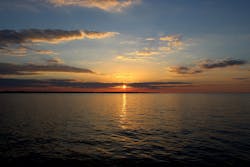Algal Blooms Threaten Drinking Water
Early estimates by the National Centre for Research Quality showed algal blooms are expected to worsen in Lake Erie. Blooms are forecasted to be just below 2015, when the level was the highest in five years.
May’s heavy rainfall, which caused more nutrient runoff from agricultural land, is the primary culprit, says the National Centre for Research Quality based in Ann Arbor, Mich. The agency, which falls under the National Oceanic and Atmospheric Administration, released its official algal bloom forecast for Lake Erie July 13. Its June 26 early estimates show the amount of phosphorus entering the lake this year is double what it was a year ago.
Several hot spots for algal blooms on Lake Erie created a crisis in 2014 when toxins produced by the green-colored scum contaminated the drinking water source for 400,000 people in the area of Toledo, Ohio, and Monroe, Mich.
“We are always talking about the forecast and whether it will be a big bloom year or small bloom year,” said Jennifer Caddick, vice president of communication for the Alliance for the Great Lakes. “It’s just a sad state that we even have to talk about the size of the algae bloom on Lake Erie. This is a significant problem affecting two countries and millions of people who rely on Lake Erie for drinking water and enjoyment of everything it has to offer. Government agencies and landowners need to get serious and address the problem.”
Government leaders from Ontario, Canada; Michigan; and Ohio agreed in 2015 to reduce the amount of phosphorus entering the lake by 40% by 2025. But the alliance believes the pledge relied too heavily on voluntary actions by landowners and regulators, Caddick said.
Manure and fertilizers are the main sources of the dangerous runoff into the lake that cause algae to thrive.
“We need a stronger mix of regulatory programs and better enforcement,” Caddick said. “The first step is the action plans. You need the two states and the Province of Ontario to sit down and get serious about what it will take. So far, the plans have been weak and not specific. When you are talking about 40%, that isn’t a drop in the bucket. You have to make significant changes.”
The alliance wants to see agreements that commit landowners, agriculture groups and government officials to reducing the ways algae-feeding nutrients flowing into Lake Erie. Wastewater treatment plants, to a lesser degree, also are a part of the problem.
“It’s especially important in the area of agriculture around the region for everyone to take the time and make the commitment for all jurisdictions to get this right,” Caddick said.
